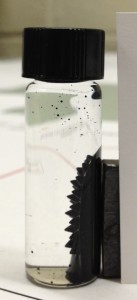Research
I am an experimentalist interested in the properties of magnetic materials on small length scales, e.g. in nanoparticles and thin films. Specific topics of interest include:
Measurement science
My postdoctoral work in the Magnetic Materials group at NIST spurred my interest in measurement science, which is one of NIST’s core missions. This has led to my research on measurements of the magnetic moment of liquid samples (see photo below). Another major interest is in the measurement science behind the assessment of nanoparticles for suitability for magnetic hyperthermia applications.
This is a ferrofluid – magnetic nanoparticles in colloidal suspension in oil. The ferrofluid displays normal field instability in the presence of a magnetic field, which means the surface becomes corrugated with “spikes” instead of being smooth. This behavior in response to a magnetic field can make it difficult to perform accurate magnetic measurements on the ferrofluid. Such measurement difficulties are the topic of some of my recent research.
Iron oxide nanoparticles
Iron oxide nanoparticles are of interest for biomedical applications because they are biocompatible. Many models used to understand the magnetic behavior of nanoparticles are single-particle models. However, there is significant evidence that interparticle interactions have a significant effect on magnetic behavior. My work on frozen solutions of iron oxide nanoparticles in water has shown that the shape of the hysteresis loop changes as a function of the field in which the sample was cooled in a Stoner-Wohlfarth-like way. This is due to induced, or colloidal, anisotropy from chain formation in the colloid in an applied field.
Chromium and chromium-aluminum alloys
Chromium is an itinerant antiferromagnet which is very sensitive to perturbations, for example due to dilute alloying, pressure, or disorder. Thin film effects such as strain and disorder also have a strong effect on the magnetic and transport properties of chromium. Chromium alloyed with aluminum (about 25%) displays semiconducting or semimetallic behavior, which up to now has been poorly understood. My research has shown that this anomalous transport behavior is a result of the band structure of the “X-phase”, a rhombohedral ordering of the bcc lattice.
